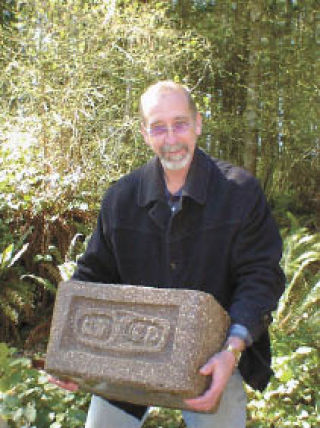by Leta Marshall
It’s a time-honored tradition to chuck the rat race, move to the islands and become an artist. Steve Ruegge, a former computer network support technician, seized the opportunity to do just that, fulfilling a dream by moving from Renton to Lopez in 2005. Since then he’s been developing both his artistic abilities and a place to work on his woodsy south-end property.
Ruegge had some experience with engineering drawing and kicked off his new career by selling pen-and-ink drawings of Lopez cabins and houses. Sales were less than enough to live on, so he kept trying different things. He took a four-day workshop with sculptor Tamara Buchanan and learned to carve stone with power tools, but it wasn’t really what he wanted to do. He researched a material called hypertufa and taught himself how to make it, and is now using it to create decorative planters and garden art.
Hypertufa is a lightweight cast stone composed of Portland cement mixed with various aggregates. It simulates some of the properties of tufa, an increasingly scarce porous volcanic stone: it’s durable, lightweight, and drains well, making it ideal for garden containers. Ruegge uses a cement mixer to mix cement, vermiculite, pumice, peat, mason sand, and other materials to make a substance similar to concrete but weighing 30 to 40 percent less. He adds iron oxide dyes to get subtle natural colors, and uses a heavy wire brush to give a surface a rugged, stone-like finish. Synthetic fibers of nylon and polypropylene are added to the mix to strengthen castings and prevent cracking. He experiments with custom concrete mixtures using lightweight aggregates and especially volcanic pumice, a common building material during the Roman empire. He points out that the ceiling of the Roman Pantheon, one of the largest free-standing domes on Earth, was built by Greek craftsmen using pumice in about 125 A.D. The structure is one of the architectural wonders of the world and has been in use nearly 2000 years.
He also models fish and northwest coast native designs in plasticine clay, then transfers the designs to polyurethane molds. The mold is then screwed to the wall of the form so that when the hypertufa is poured into the form, the design becomes part of the planter. He puts the mixture into forms and lets them sit for 24 hours, then seals the forms in black plastic garbage bags to cure for 28 days. This keeps the moisture in so that the hypertufa retains its strength.
Ruegge is testing his products and watching how they perform over time before marketing them widely. For example, he soaked a small hypertufa planter in water, then put it in his freezer, then back in the water, then the freezer, a total of 55 times to see how it would survive the freeze-thaw cycle over many northwest winters. The container passed the test.
Before he set up an assembly line, Ruegge could pour five troughs a week; now he can make five a day, and has plans to increase production even more. Currently he is casting garden containers of one pint up to five-gallon capacity with integrated custom artwork. The largest weigh 80 pounds each, about as much as he can lift.
Last year Ruegge turned one end of his small abode into a petunia nursery, growing the plants from seed. When they began to flower he planted them in his troughs and took them around to bed-and-breakfasts, whose owners snapped them up.
Like most artists, Ruegge enjoys figuring out how to turn his ideas into reality and experimenting with different materials. He’s incorporated a container made of white cement and mortar into a large piece of driftwood, and last year he created a chinook salmon by building up cement over a styrofoam core – “the two ugliest materials, styrofoam and cement,” he says. That work sold at an auction.
Ruegge says, “I always worked for big companies, where there was someone telling you what to do, how to do it, and how high to jump.” Occasionally he hears that little voice that says, “Get a real job,” but for now he’s enjoying the freedom to schedule his own days and explore his own ideas.
May 23 through 25, Ruegge will show his work in the Lopez Sculpture in the Garden art show. Currently his hypertufa troughs are available at Northwest art and craft shows, and by phone. For more information, call Steve Ruegge at 468-3404.



